Physical Address
304 North Cardinal St.
Dorchester Center, MA 02124
Germ cell tumors (GCTs) are a heterogeneous group that are widely considered to be morphologic and immunophenotypic homologues of germinal neoplasms arising in the gonads and extragonadal sites. The World Health Organization (WHO) classification of GCTs of the central nervous system (CNS) is therefore similar to that of other sites: germinoma (denoted as seminoma in the testis and dysgerminoma in the ovary), teratoma (mature, immature, and with secondary malignancy), yolk sac tumor, embryonal carcinoma, choriocarcinoma, and mixed tumors ( Box 18.1 ). Yet GCTs of the CNS differ from their gonadal counterparts in many aspects, including morphology, clinical behavior, and possibly their origin. Unlike testicular GCTs, tumors of the CNS lack the precursor lesions of carcinoma in situ/intratubular germ cell neoplasia, and there is no CNS equivalent to spermatocytic seminoma. Furthermore, GCTs of the testis show stark differences in clinical behavior and prognosis between prepubertal and postpubertal patients—a phenomenon not paralleled in the CNS. As the clinical behavior of the various histologic types of GCTs and their response to therapy were shown to be vastly different, there had been a natural grouping of GCT variants into two major therapeutically relevant diagnostic categories: germinomas and nongerminomatous germ cell tumors (NGCTs), with teratomas often considered a separate category. With emerging data on long-term clinical outcome, however, this classification strategy has been a target of criticism.
Germinomas
Nongerminomatous germ cell tumors
Embryonal carcinoma
Yolk sac tumor
Choriocarcinoma
Teratoma
Benign teratoma
Immature teratoma
Teratoma with malignant transformation
Mixed germ cell tumors
Krabbe first introduced the term “pinealoma” in 1923 to describe an “adenoma of the pineal body”—regarded today as pineocytoma, and the term was subsequently applied to all pineal tumors including germinomas. Indeed, publications as recent as 1976 referred to GCTs as “pinealomas.” Russell was the first to propose a relationship between pinealoma and GCTs when she referred to germinoma as “atypical pineal teratoma.” However, it was not until the 1970s that this concept achieved wide recognition. The pathogenesis of GCTs in general and those of the CNS in particular remains a subject of intense debate. As in testicular GCTs, the most prevalent theory is that GCTs arise from primordial germ cells and hence the term “germinoma” coined by Friedman and Moore in 1946. The basis of the “germ cell theory” in extragonadal sites is the aberrant migration of primordial germ cells during embryonic development followed by secondary malignancy. To explain the multiple histologic subtypes of GCTs, the germ cell theory employs the concept of a common cell of origin, but one that is totipotent (i.e., a stem cell that has the potential to differentiate into any kind of tissue during the first few divisions of a fertilized egg). Under these provisions, the germ cell theory paradoxically implies that the biologically more indolent germinomas arise from the most undifferentiated germ cells, whereas the most malignant forms of GCTs (choriocarcinoma and yolk sac tumor) arise from highly differentiated germ cells. That, and the notion that the germ cell theory employs parthenogenesis in humans, and the lack of a plausible explanation of the mechanism through which primordial germ cells mismigrate to the cranial cavity, led to its challenge by Sano and colleagues who proposed the alternative “embryonic cell theory.” This suggests that a mismigrational pluripotent embryonic cell (i.e., a stem cell at the blastocyst stage, past the stage of a totipotent stem cell) gives rise to intracranial GCTs. Contrary to the germ cell theory, which advocates that all types of GCTs arise from a common cell of origin (primordial germ cell), the embryonic cell theory suggests the involvement of multiple embryonic cells of various stages of embryogenesis.
Recently, a genomewide methylation profiling study of primary intracranial GCTs revealed distinct methylation patterns for pure germinomas (low methylation) from all other GCT subtypes (high methylation). Both, however, were strongly associated with MAPK/PI3K pathway. The close resemblance of the methylation pattern of pure germinomas to that of primordial germ cells suggests a possible pathogenetic association. Furthermore, the shared identical somatic mutations in the MAPK/PI3K pathway indicate that GCTs likely develop through combined genetic and epigenetic mechanisms from a common ancestral cell.
GCTs vary greatly in incidence geographically. They are most common in Far East Asia and Japan where they represent up to 15% of all pediatric brain tumors, but are relatively infrequent in the Western Hemisphere where they account for only 0.1% to 3.4% of all primary intracranial neoplasms. GCTs of the CNS have been reported in all ages, but the vast majority (>90%) affect patients younger than 25 years of age, most occurring in the second decade; their peak coincides with the onset of puberty. The age distribution generally is similar among GCT subtypes, but patients with teratoma or choriocarcinoma have a tendency to be a decade younger, while pure germinomas are more commonly seen in older patients. Congenital examples, typically in the form of teratomas, are well recognized, as are rare late adult-onset cases.
Overall, intracranial GCTs are significantly more frequent in boys, with a male-to-female ratio of up to 3.8 to 1. However, significant regional and histologic variations occur. Male predominance is maintained throughout all histologic subtypes, being most pronounced in teratomas and least recorded in germinomas. Pineal and basal ganglionic GCTs are decidedly more common in males, whereas those of the suprasellar region show a slight female predominance, as do congenital neoplasms.
Patients with Klinefelter syndrome and Down syndrome have higher risks of developing germ cell tumors. Isolated cases have been reported in association with neurofibromatosis type I, in siblings of GCT patients, or in association with gonadal GCTs.
Midline locations (primarily pineal/third ventricular regions [ Fig. 18.1 ], followed by the suprasellar compartment [ Fig. 18.2 ]) account for over two-thirds of intracranial GCTs. Less common sites include the basal ganglia ( Fig. 18.3 ), thalamus, ventricular system, cerebral hemispheres, posterior fossa, spinal cord, orbit, and extracranial soft tissues. Congenital teratomas that occur outside the cranial cavity (sacrococcygeal, cervical, etc.) are beyond the scope of this chapter; however, intracranial examples are briefly discussed in a later section. Massive intracranial or so-called holocranial variants, usually in the form of congenital teratomas, are rarely encountered. With the recent advances in imaging studies and endoscopic procedures, multifocal examples, including synchronous and metachronous GCTs combining pineal and neurohypophysial lesions ( Fig. 18.4 ) or occasional bilateral thalamic and basal ganglionic tumors, are now increasingly recognized. Germinomas predominate in the suprasellar and basal ganglionic/thalamic regions, whereas NGCTs dominate at other sites. GCTs occasionally disseminate along the cerebrospinal fluid (CSF) pathways, but rarely metastasize extracranially.

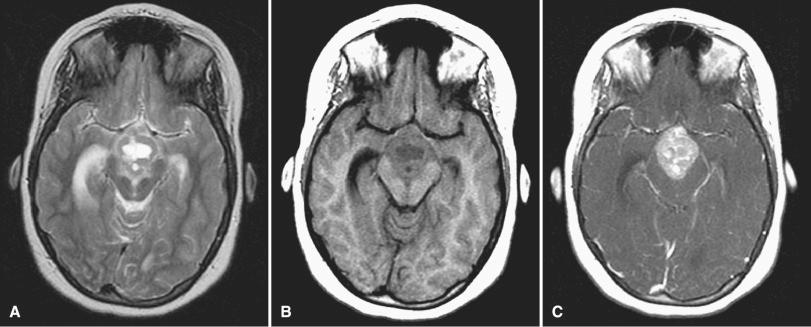
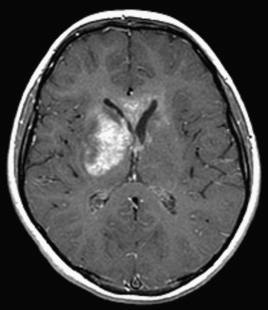
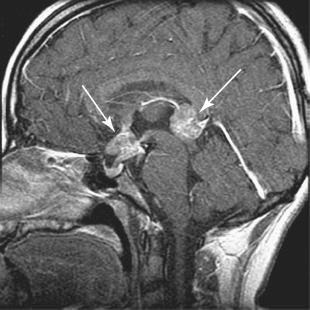
The clinical presentation of GCTs varies according to their sites of involvement. Pineal region tumors produce symptoms stemming from either aqueductal compression (increased intracranial pressure) or distortion of the quadrigeminal plate (mental status changes, upward gaze palsies and convergence—Parinaud syndrome ). Pineal or hypothalamic tumors also may result in precocious puberty. The triad of diabetes insipidus, loss of visual acuity, and hypopituitarism is characteristic of suprasellar tumors. In fact, young patients who present with diabetes insipidus should be suspected of having a GCT since other suprasellar neoplasms (pilocytic astrocytoma and craniopharyngioma) manifest diabetes insipidus only late in the disease process or soon after surgery.
The radiographic and gross features of GCTs are relatively nonspecific ; however, the differential diagnosis is usually heavily influenced by the location and clinical history. On T1-weighted magnetic resonance imaging (MRI), GCTs are typically hypointense to gray matter (see Fig. 18.1A ), while on T2-weighted and fluid-attenuated inversion recovery imaging, they are mainly hyperintense with variable components of isointensity and hypointensity ( Fig. 18.1B ). Most are isointense on diffusion-weighted images. The vast majority are intensely but heterogeneously enhancing on both computed tomography and MRI ( Fig. 18.1C ). Nonteratomatous GCTs are mostly solid and well circumscribed, though rare basal ganglionic or thalamic examples may appear ill defined. Tumor size varies considerably, ranging from 0.4 to 12.5 cm. Calcification is frequently observed in pineal tumors, but hemorrhage is exceptional and suggests the diagnosis of choriocarcinoma. Teratomas are characteristically complex solid-cystic masses with frequent calcifications and fat. Local invasion of adjacent structures is observed in approximately two-thirds of GCTs, particularly germinomas ( Fig. 18.1C ). Sites of direct local invasion include the optic apparatus/chiasm, the cavernous sinus, third ventricle, and corpus callosum. Seeding of CSF is unusual but may manifest as nodular or linear foci of contrast enhancement. Most pineal GCTs result in hydrocephalus as compared with about one-third of those arising along the hypothalamic/hypophyseal axis.
As mentioned, GCTs are divided into five major histologic variants: germinomas, teratomas, embryonal carcinomas, yolk sac tumors, and choriocarcinomas. Two or more of these variants can combine to form a mixed germ cell tumor.
Classic germinomas are made up of sheets, lobules, and nests of large polygonal tumor cells interspersed by thin fibroinflammatory septa, rich in T lymphocytes ( Fig. 18.5A ). Lymphocytes frequently spill into the lobules and can occasionally be so abundant as to obscure the germinoma cells ( Fig. 18.5B ). In well-preserved, formalin-fixed samples, tumor cells are characterized by fairly distinct cytoplasmic borders and a clear or vacuolated, periodic acid–Schiff (PAS)–positive cytoplasm, reflecting high glycogen content. The nuclei are centrally placed, large, vesicular, and round to polygonal with prominent irregular nucleoli. Mitoses are usually readily identified but the tumor cells are relatively monomorphous ( Fig. 18.5C ). Some germinomas, known as desmoplastic variants, are characterized by thick bands of fibrous tissue decorating cords and trabeculae of tumor cells. Noncaseating granulomatous inflammation is found in a small subset of germinomas, and the granulomas may or may not appear well formed ( Fig. 18.5D ); one must be cautious in such cases not to suggest a diagnosis of sarcoidosis or infection when associated germinoma cells are less conspicuous ( Fig. 18.5D arrows; see Differential Diagnosis section). The proportion of classic germinoma cells to inflammation varies considerably from case to case, and when the latter predominates, diagnostic tumor cells may be easily overlooked ( Fig. 18.5B ). Necrosis, either confluent or of individual cells, is a frequent finding, and calcifications are occasionally encountered ( Fig. 18.5C and E ). Most germinomas lack syncytiotrophoblastic giant cells, but their presence in otherwise classic germinomas should not prompt the diagnosis of choriocarcinoma ( Fig. 18.5F ).
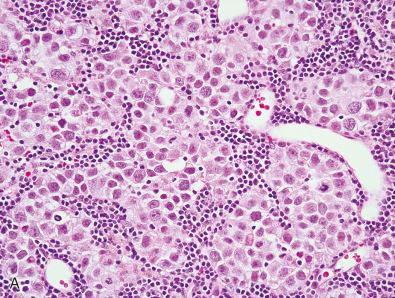
Germinoma cells often form solid masses in some portions, but are also capable of infiltrating the brain parenchyma in a fashion similar to malignant gliomas or lymphomas, in which case immunostains become essential in arriving at the correct diagnosis ( Fig. 18.6 ).
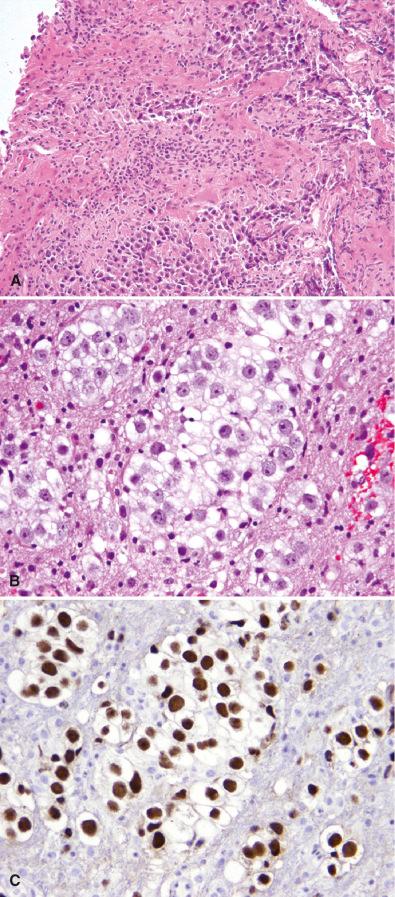
Smear or crush preparations can be exceptionally helpful in the intraoperative diagnosis of germinoma, in which the malignant large round tumor cells are admixed with a population of small mature lymphocytes ( Fig. 18.7 ). Cytologic preparations offer the advantage of superior preservation of the nuclear morphology over frozen section preparations and allow for judicious use of very precious biopsy tissue (see Chapter 3 ). When possible, attempts should be made to minimize the handling of biopsy material and save unfrozen tissue for the potential use of immunohistochemical stains.
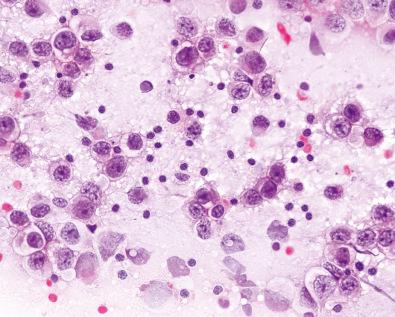
Unlike germinomas, embryonal carcinomas rarely present in pure form and are usually part of mixed malignant GCTs. The cells of embryonal carcinoma may be arranged in several patterns, including solid cohesive sheets, cords, incomplete papillae, or gland-like spaces ( Fig. 18.8A and B ). Toward the periphery of the solid pattern, dark degenerate-appearing, smudged cells may resemble syncytiotrophoblasts, but they should not be confused with cells indicative of choriocarcinoma ( Fig. 18.8C ). Foci of necrosis, either confluent or of individual cells, are common ( Fig. 18.8D ). Fibrous bands ( Fig. 18.8D ) and granulomatous inflammation are much less frequently encountered than in germinomas, but small foci of neoplastic poorly differentiated stroma may accompany embryonal carcinoma ( Fig. 18.8E ). Evidence is mounting that the neoplastic-looking stroma is indeed teratomatous, even though not all investigators are convinced. Furthermore, the presence of this type of teratomatous element is one reason why such patients may fail chemotherapy because these components may not respond. Tumor cells are generally large, polygonal, more pleomorphic, and more carcinoma-like than those of germinoma. Their cytoplasmic borders are less discernable, causing a syncytial appearance. Cytoplasm is usually abundant, somewhat granular, and can be basophilic, amphophilic, eosinophilic, or, less frequently, clear and vacuolated. Nuclei are large, generally round but with irregular contours, occasionally overlapping, and have large sometimes multiple nucleoli ( Fig. 18.8F ). The mitotic rate is typically high ( Fig. 18.8G ). As with germinomas, syncytiotrophoblasts may be encountered, albeit more frequently ( Fig. 18.8H ).
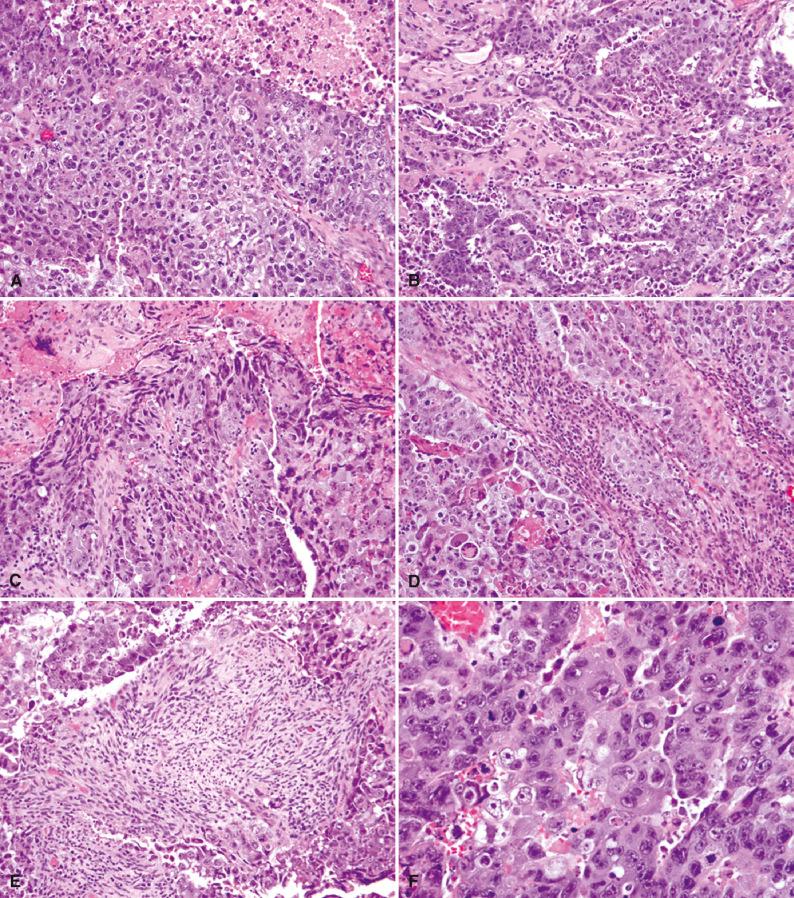
Previously referred to as endodermal sinus tumors, yolk sac tumors are exceptional in pure form but more commonly admixed with germinomas and immature teratomas. Yolk sac tumors are commonly recognized by one or more of the many different morphologic patterns they may acquire. A reticular or microcystic architecture ( Fig. 18.9A ), consisting of an intervening meshwork of tissue spaces of varying sizes, is the most common single pattern, but a mixture of patterns is the rule. As microcysts coalesce, a macrocystic pattern is seen ( Fig. 18.9B ). The famous Schiller-Duval bodies characterize the endodermal sinus pattern and consist of tufts of malignant cuboidal-to-columnar tumor cells surrounding central blood vessels ( Fig. 18.9C ). When longitudinally or obliquely cut, these structures result in fibrous or fibrovascular cores that appear draped (festooned) by malignant epithelial cells. Papillae, rimmed by cells with scant cytoplasm projecting into cystic spaces, characterize the papillary pattern ( Fig. 18.9D ), whereas sheet-like arrangements of polygonal tumor cells form the solid pattern ( Fig. 18.9E ). The glandular pattern, consisting of alveolar-like spaces or enteric-type glands, is common but rare in pure form ( Fig. 18.9F and G ). A myxoid stroma is commonly associated with the reticular pattern. Rare yolk sac tumors show a sarcomatoid component. The polyvesicular vitelline pattern is formed by eccentrically constricted cysts/vesicles lined by flat-to-columnar epithelium ( Fig. 18.9H ). Clusters of liver-like cells are seen in the hepatoid pattern, and basement membrane–rich matrix containing neoplastic cells is evidence of parietal differentiation ( Fig. 18.9I ), that is, resembling the early embryologic stage of rodent parietal endoderm.
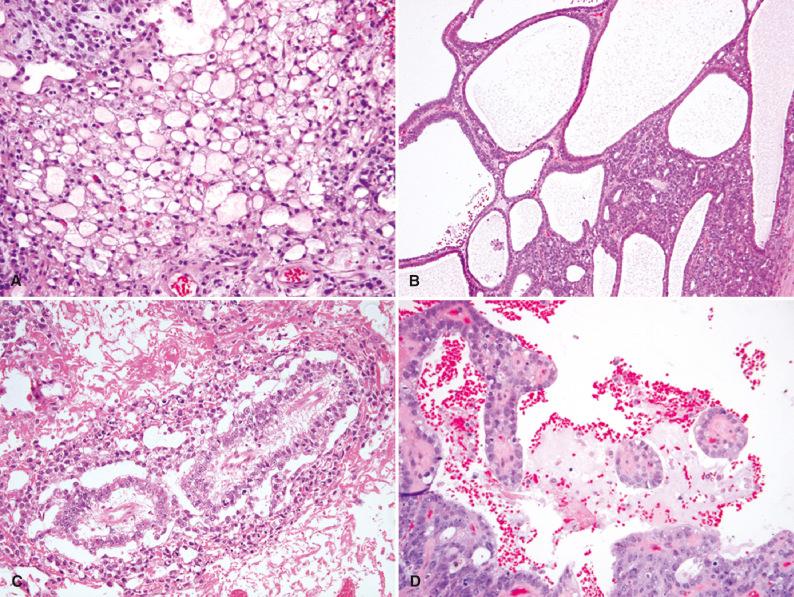
Although they may show a prominent vascular network, yolk sac tumors typically lack the fibrous septa and prominent lymphocytic infiltrate that characterize germinomas. Neoplastic cells are large, polygonal, and have fairly well-defined cytoplasmic borders and a faintly eosinophilic or clear cytoplasm ( Fig. 18.9J ). Their nuclei are relatively uniform and nonoverlapping with nucleoli that are usually less prominent than those of germinoma or embryonal carcinoma. Mitotic activity is highly variable. A characteristic feature is the presence of PAS-positive/diastase-resistant, variably sized, hyaline eosinophilic globules that are typically found in the cytoplasm, but may appear within the extracellular spaces ( Fig. 18.9K ). Another diagnostically helpful finding, and perhaps a more frequent one than hyaline globules, is the presence of intercellular basement membrane generally arranged as thick, longitudinal bands of eosinophilic material. These are felt to represent a neoplastic reiteration of the parietal yolk sac ( Fig. 18.9I ), contrasting with the visceral yolk sac differentiation of hyaline globules.
The subject of teratoma, regardless of site of occurrence, is rather complex and confusing. Adding to this confusion is the observation that morphologically similar teratomas show biologic behaviors that vary based on location and patient age. For gonadal tumors, most ovarian teratomas are benign and most testicular teratomas are malignant, with the exception of those occurring in children. Accordingly, teratomas of the ovary are thought to derive from a benign germ cell in a parthenogenetic-like fashion (i.e., without sexual fertilization), whereas postpubertal testicular teratomas derive from a malignant germ cell that likely developed in utero and that progressed through an invasive germ cell tumor (embryonal carcinoma, yolk sac tumor, etc.) before undergoing an end-stage differentiation toward teratoma. The experience with teratomas of the CNS suggests that their biologic behavior more closely parallels that of ovarian teratomas. As such, pure teratomas of the CNS that lack immature or secondary malignant elements are probably benign (assuming they arise from benign cells of origin), whereas teratomas that are admixed with malignant forms of GCTs (embryonal carcinoma, yolk sac tumor, and choriocarcinoma) are probably malignant regardless of their degree of maturity (assuming they arise from malignant cells of origin). Therefore, one need not venture into the unnecessary exercise of further subcategorizing teratomas of mixed malignant GCTs into mature or immature, as all of these teratomas are, by definition, malignant. The presence of a secondary malignant component appears to be of added prognostic and therapeutic value and therefore should be mentioned.
Mature teratomas are solid and cystic neoplasms made up of highly differentiated, adult-type tissues displayed in a variably organized manner. Tissue elements do not necessarily conform to a specific anatomic site, although occasional organ specialization (e.g., brain or retina) can be seen. Commonly, all three germ cell layers are represented ( Fig. 18.10A ). Ectodermal elements ( Fig. 18.10A–C ) may include skin, brain, and choroid plexus, whereas a typically hypocellular fibrous stroma admixed with smooth muscle ( Fig. 18.10D ), occasional adipose tissue, and cellular nodules of cartilage ( Fig. 18.10E ) represent the mesoderm. Glandular epithelium of enteric, respiratory, or even transitional type accounts for endodermal derivation ( Fig. 18.10F ). The presence of focal increased cellularity, mitotic activity, or even moderate cytologic atypia identified in either the mesenchymal or epithelial components should not prompt an immature teratoma diagnosis. Only tumors closely resembling embryonal tissue types may be regarded as immature teratomas (see following section).

Become a Clinical Tree membership for Full access and enjoy Unlimited articles
If you are a member. Log in here